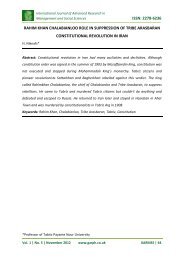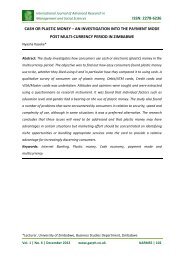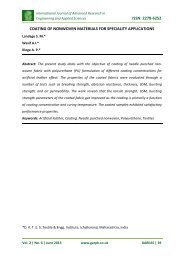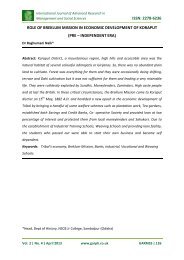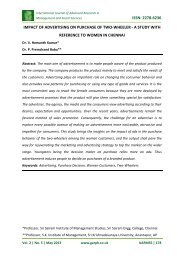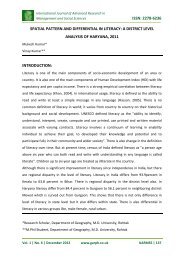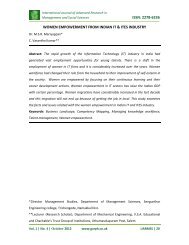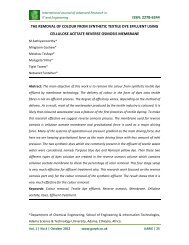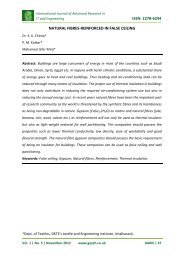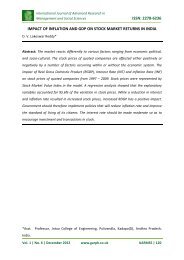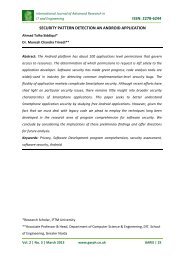issn: 2278-6236 foreign direct investment in india - Garph.co.uk
issn: 2278-6236 foreign direct investment in india - Garph.co.uk
issn: 2278-6236 foreign direct investment in india - Garph.co.uk
You also want an ePaper? Increase the reach of your titles
YUMPU automatically turns print PDFs into web optimized ePapers that Google loves.
V. Krishnaveni*<br />
Dr. R. Haridas**<br />
International Journal of Advanced Research <strong>in</strong><br />
Management and Social Sciences ISSN: <strong>2278</strong>-<strong>6236</strong><br />
FOREIGN DIRECT INVESTMENT IN INDIA<br />
Abstract: It is nowadays accepted that FDI plays a crucial role <strong>in</strong> <strong>in</strong>dustrial development of<br />
the developed and develop<strong>in</strong>g <strong>co</strong>untries alike and can help <strong>in</strong> boost<strong>in</strong>g e<strong>co</strong>nomic growth<br />
through, for example, total factor productivity growth. FDI <strong>in</strong>creas<strong>in</strong>g <strong>co</strong>mprises sets of<br />
<strong>in</strong>ter-<strong>co</strong>nnected operationalized bus<strong>in</strong>ess decisions by mult<strong>in</strong>ational enterprises (MNEs) <strong>in</strong><br />
response to chang<strong>in</strong>g global and regional <strong>co</strong>mpetitive, strategic <strong>co</strong>nsiderations and factor<br />
<strong>co</strong>nditions. As such, FDI Policy Instruments, which have analytical and regulatory<br />
dimensions, are required to manage the landscape of MNEs’ FDI operations <strong>in</strong> order to<br />
maximize positive externalities accru<strong>in</strong>g to the host location, as well as optimiz<strong>in</strong>g the<br />
allocative efficiencies <strong>in</strong>volved <strong>in</strong> FDI. Ac<strong>co</strong>rd<strong>in</strong>g to UNIDO (2003), the policy framework for<br />
FDI is a crucial part of the overall national strategy for <strong>in</strong>dustrialization. As the ratio of<br />
<strong>in</strong>ward FDI to GDP is, <strong>in</strong> general, relatively high for develop<strong>in</strong>g <strong>co</strong>untries <strong>in</strong> <strong>co</strong>mparison to<br />
<strong>in</strong>dustrialized <strong>co</strong>untries, the role of well-designed FDI Policy Instruments <strong>in</strong> e<strong>co</strong>nomic<br />
development cannot be over estimated. From the out set, one needs to appreciate that<br />
when reference is made to the advantages and disadvantages of FDI Policy Instruments, it is<br />
<strong>in</strong> terms of the relative merits of the policy tools. It is also important to <strong>in</strong>dicate that, from a<br />
policy perspective, the pros and <strong>co</strong>ns of Policy Instruments are framed by <strong>co</strong>nsiderations of<br />
who ga<strong>in</strong>s or loses. This is not a trival issue, depend<strong>in</strong>g not only on the demographic<br />
structure of employment distribution of the labour force <strong>in</strong> the e<strong>co</strong>nomy, but also on the<br />
chang<strong>in</strong>g nature of the relative balance of <strong>co</strong>mpetitive advantage.<br />
*Assistant Professor & Research Scholar, Department of Management (UG), Karpagam<br />
University, Coimbatore.<br />
Professor and Head, Department of Bus<strong>in</strong>ess Adm<strong>in</strong>istration, Government Arts College for<br />
Men, Krishnagiri.<br />
Vol. 2 | No. 5 | May 2013 www.garph.<strong>co</strong>.<strong>uk</strong> IJARMSS | 232
International Journal of Advanced Research <strong>in</strong><br />
Management and Social Sciences ISSN: <strong>2278</strong>-<strong>6236</strong><br />
INTRODUCTION<br />
Foreign <strong><strong>in</strong>vestment</strong> was <strong>in</strong>troduced <strong>in</strong> 1991 as Foreign Exchange Management Act (FEMA),<br />
driven by F<strong>in</strong>ance M<strong>in</strong>ister Manmohan S<strong>in</strong>gh. As S<strong>in</strong>gh subsequently became a prime<br />
m<strong>in</strong>ister, this has been one of his top political problems, even <strong>in</strong> the current (2012) election.<br />
India disallowed overseas <strong>co</strong>rporate bodies (OCB) to <strong>in</strong>vest <strong>in</strong> India. Start<strong>in</strong>g from a basel<strong>in</strong>e<br />
of less than $1 billion <strong>in</strong> 1990, a recent UNCTAD survey projected India as the se<strong>co</strong>nd most<br />
important FDI dest<strong>in</strong>ation (after Ch<strong>in</strong>a) for transnational <strong>co</strong>rporations dur<strong>in</strong>g 2010–2012. As<br />
per the data, the sectors that attracted higher <strong>in</strong>flows were services, tele<strong>co</strong>mmunication,<br />
<strong>co</strong>nstruction activities and <strong>co</strong>mputer software and hardware. Mauritius, S<strong>in</strong>gapore, US and<br />
UK were among the lead<strong>in</strong>g sources of FDI. Based on UNCTAD data FDI flows were $10.4<br />
billion, a drop of 43% from the first half of the last year.<br />
Foreign <strong>direct</strong> <strong><strong>in</strong>vestment</strong> (FDI) is a <strong>direct</strong> <strong><strong>in</strong>vestment</strong> <strong>in</strong>to production or bus<strong>in</strong>ess <strong>in</strong> a<br />
<strong>co</strong>untry by a <strong>co</strong>mpany <strong>in</strong> another <strong>co</strong>untry, either by buy<strong>in</strong>g a <strong>co</strong>mpany <strong>in</strong> the target <strong>co</strong>untry<br />
or by expand<strong>in</strong>g operations of an exist<strong>in</strong>g bus<strong>in</strong>ess <strong>in</strong> that <strong>co</strong>untry. Foreign <strong>direct</strong><br />
<strong><strong>in</strong>vestment</strong> is <strong>in</strong> <strong>co</strong>ntrast to portfolio <strong><strong>in</strong>vestment</strong> which is a passive <strong><strong>in</strong>vestment</strong> <strong>in</strong> the<br />
securities of another <strong>co</strong>untry such as stocks and bonds.<br />
The above pictures show that the mean<strong>in</strong>g of the term Foreign Direct Investment.<br />
DEFINITIONS<br />
Foreign <strong>direct</strong> <strong><strong>in</strong>vestment</strong> has many forms. Broadly, <strong>foreign</strong> <strong>direct</strong> <strong><strong>in</strong>vestment</strong> <strong>in</strong>cludes<br />
"mergers and acquisitions, build<strong>in</strong>g new facilities, re<strong>in</strong>vest<strong>in</strong>g profits earned from overseas<br />
operations and <strong>in</strong>tra <strong>co</strong>mpany loans".<br />
In a narrow sense, <strong>foreign</strong> <strong>direct</strong> <strong><strong>in</strong>vestment</strong> refers just to build new facilities. The numerical<br />
FDI figures based on varied def<strong>in</strong>itions are not easily <strong>co</strong>mparable.<br />
As a part of the national ac<strong>co</strong>unts of a <strong>co</strong>untry, and <strong>in</strong> regard to the national <strong>in</strong><strong>co</strong>me<br />
equation Y=C+I+G+(X-M), I is <strong><strong>in</strong>vestment</strong> plus <strong>foreign</strong> <strong><strong>in</strong>vestment</strong>, FDI is def<strong>in</strong>ed as the net<br />
<strong>in</strong>flows of <strong><strong>in</strong>vestment</strong> (<strong>in</strong>flow m<strong>in</strong>us outflow) to acquire a last<strong>in</strong>g management <strong>in</strong>terest (10<br />
Vol. 2 | No. 5 | May 2013 www.garph.<strong>co</strong>.<strong>uk</strong> IJARMSS | 233
International Journal of Advanced Research <strong>in</strong><br />
Management and Social Sciences ISSN: <strong>2278</strong>-<strong>6236</strong><br />
percent or more of vot<strong>in</strong>g stock) <strong>in</strong> an enterprise operat<strong>in</strong>g <strong>in</strong> an e<strong>co</strong>nomy other than that<br />
of the <strong>in</strong>vestor.<br />
TYPES OF FOREIGN DIRECT INVESTMENT<br />
<br />
Horizontal FDI arises when a firm duplicates its home <strong>co</strong>untry-based activities at the<br />
same value cha<strong>in</strong> stage <strong>in</strong> a host <strong>co</strong>untry through FDI.<br />
<br />
Platform FDI<br />
Vertical FDI takes place when a firm through FDI moves upstream or downstream <strong>in</strong><br />
different value cha<strong>in</strong>s i.e., when firms perform value-add<strong>in</strong>g activities stage by stage <strong>in</strong> a<br />
vertical fashion <strong>in</strong> a host <strong>co</strong>untry.<br />
Vol. 2 | No. 5 | May 2013 www.garph.<strong>co</strong>.<strong>uk</strong> IJARMSS | 234
International Journal of Advanced Research <strong>in</strong><br />
Management and Social Sciences ISSN: <strong>2278</strong>-<strong>6236</strong><br />
Horizontal FDI decreases <strong>in</strong>ternational trade as the product of them is usually aimed at host<br />
<strong>co</strong>untry; the two other types generally act as a stimulus for it.<br />
METHODS OF FOREIGN DIRECT INVESTMENT<br />
The <strong>foreign</strong> <strong>direct</strong> <strong>in</strong>vestor may acquire vot<strong>in</strong>g power of an enterprise <strong>in</strong> an e<strong>co</strong>nomy<br />
through any of the follow<strong>in</strong>g methods:<br />
<br />
<br />
<br />
<br />
by <strong>in</strong><strong>co</strong>rporat<strong>in</strong>g a wholly owned subsidiary or <strong>co</strong>mpany anywhere<br />
by acquir<strong>in</strong>g shares <strong>in</strong> an associated enterprise<br />
through a merger or an acquisition of an unrelated enterprise<br />
participat<strong>in</strong>g <strong>in</strong> an equity jo<strong>in</strong>t venture with another <strong>in</strong>vestor or enterprise<br />
Foreign <strong>direct</strong> <strong><strong>in</strong>vestment</strong> <strong>in</strong>centives may take the follow<strong>in</strong>g forms<br />
<br />
<br />
<br />
<br />
<br />
<br />
<br />
<br />
<br />
<br />
<br />
<br />
<br />
<br />
<br />
low <strong>co</strong>rporate tax and <strong>in</strong>dividual <strong>in</strong><strong>co</strong>me tax rates<br />
tax holidays<br />
other types of tax <strong>co</strong>ncessions<br />
preferential tariffs<br />
special e<strong>co</strong>nomic zones<br />
EPZ – Export Process<strong>in</strong>g Zones<br />
Bonded Warehouses<br />
Maquiladoras<br />
<strong><strong>in</strong>vestment</strong> f<strong>in</strong>ancial subsidies<br />
soft loan or loan guarantees<br />
free land or land subsidies<br />
relocation & expatriation<br />
<strong>in</strong>frastructure subsidies<br />
R&D support<br />
derogation from regulations (usually for very large projects)<br />
FOREIGN TECHNOLOGY COLLABORATION AGREEMENT<br />
RBI has delegated the powers, to make payments for royalty, lump sum fee for transfer of<br />
technology and payment for use of trademark/brand name <strong>in</strong> terms of the <strong>foreign</strong><br />
technology <strong>co</strong>llaboration agreement entered by the Indian <strong>co</strong>mpany with its <strong>foreign</strong><br />
partners, to the AD banks subject to <strong>co</strong>mpliance with the provisions of Foreign Exchange<br />
Vol. 2 | No. 5 | May 2013 www.garph.<strong>co</strong>.<strong>uk</strong> IJARMSS | 235
International Journal of Advanced Research <strong>in</strong><br />
Management and Social Sciences ISSN: <strong>2278</strong>-<strong>6236</strong><br />
Management (Current Ac<strong>co</strong>unt Transactions) Rules, 2000. Further, the requirement of<br />
registration of the agreement with the Regional Office of Reserve Bank of India has also<br />
been done away with.<br />
In the above the Wal*Mart Company is will<strong>in</strong>g to trade with India and make the agreements<br />
also. And It shows the FDI <strong>in</strong> India from the start<strong>in</strong>g year 1991 to 2002. The developed<br />
world also receives its fair share of cross-border <strong><strong>in</strong>vestment</strong>, but of a different nature. Most<br />
of this is mergers and acquisitions between mature <strong>co</strong>mpanies.<br />
Foreign <strong>direct</strong> <strong><strong>in</strong>vestment</strong> is of grow<strong>in</strong>g importance to global e<strong>co</strong>nomic growth. This is<br />
especially for develop<strong>in</strong>g and emerg<strong>in</strong>g market <strong>co</strong>untries. FDI from <strong>in</strong>vestors <strong>in</strong> developed<br />
areas like the EU and the U.S. provide fund<strong>in</strong>g and expertise to help smaller <strong>co</strong>mpanies <strong>in</strong><br />
these emerg<strong>in</strong>g markets to expand and <strong>in</strong>crease <strong>in</strong>ternational sales. Until recently,<br />
Southeast Asia was the greatest beneficiary of FDI. However, as of 2011, Lat<strong>in</strong> America and<br />
the Caribbean pulled ahead, receiv<strong>in</strong>g a 35% <strong>in</strong>crease <strong>in</strong> FDI. These already-global<br />
<strong>co</strong>rporations are engaged <strong>in</strong> restructur<strong>in</strong>g or refocus<strong>in</strong>g on <strong>co</strong>re bus<strong>in</strong>esses. However, it gets<br />
re<strong>co</strong>rded as FDI. This type of <strong><strong>in</strong>vestment</strong> is more about ma<strong>in</strong>tenance, and less about mak<strong>in</strong>g<br />
great stride <strong>in</strong> e<strong>co</strong>nomic growth. (Source: UNCTAD, Annual FDI Report)<br />
Vol. 2 | No. 5 | May 2013 www.garph.<strong>co</strong>.<strong>uk</strong> IJARMSS | 236
International Journal of Advanced Research <strong>in</strong><br />
Management and Social Sciences ISSN: <strong>2278</strong>-<strong>6236</strong><br />
ADVANTAGES OF FOREIGN DIRECT INVESTMENT<br />
Foreign <strong>direct</strong> <strong><strong>in</strong>vestment</strong> has many advantages for both the <strong>in</strong>vestor and the recipient. One<br />
of the primary benefits is that it allows money to freely go to whatever bus<strong>in</strong>ess has the<br />
best prospects for growth anywhere <strong>in</strong> the world. That's because <strong>in</strong>vestors aggressively seek<br />
the best return for their money with the least risk. This motive is <strong>co</strong>lor-bl<strong>in</strong>d, doesn't care<br />
about religion or form of government.<br />
This gives well-run bus<strong>in</strong>esses -- regardless of race, <strong>co</strong>lor or creed -- a <strong>co</strong>mpetitive<br />
advantage. It reduces (but, of <strong>co</strong>urse, doesn't elim<strong>in</strong>ate) the effects of politics, cronyism and<br />
bribery. As a result, the smartest money goes to the best bus<strong>in</strong>esses all over the world,<br />
br<strong>in</strong>g<strong>in</strong>g these goods and services to market faster than if unrestricted FDI weren't available.<br />
Investors receive additional benefits. Their risk is reduced because they can diversify their<br />
hold<strong>in</strong>gs outside of a specific <strong>co</strong>untry, <strong>in</strong>dustry or political system. Diversification always<br />
<strong>in</strong>creases return without <strong>in</strong>creas<strong>in</strong>g risk.<br />
Bus<strong>in</strong>esses benefit by receiv<strong>in</strong>g management, ac<strong>co</strong>unt<strong>in</strong>g or legal guidance <strong>in</strong> keep<strong>in</strong>g with<br />
the best practices practiced by their lenders. They can also <strong>in</strong><strong>co</strong>rporate the latest<br />
technology, <strong>in</strong>novations <strong>in</strong> operational practices, and new f<strong>in</strong>anc<strong>in</strong>g tools that they might<br />
not otherwise be aware of. By adopt<strong>in</strong>g these practices, they enhance their employees'<br />
lifestyles, help<strong>in</strong>g to create a better standard of liv<strong>in</strong>g for the recipient <strong>co</strong>untry. In addition,<br />
s<strong>in</strong>ce the best <strong>co</strong>mpanies get rewarded with these benefits, local governments have less<br />
<strong>in</strong>fluence, and aren't as able to pursue poor e<strong>co</strong>nomic policies.<br />
The standard of liv<strong>in</strong>g <strong>in</strong> the recipient <strong>co</strong>untry is also improved by higher tax revenue from<br />
the <strong>co</strong>mpany that received the <strong>foreign</strong> <strong>direct</strong> <strong><strong>in</strong>vestment</strong>. However, sometimes <strong>co</strong>untries<br />
neutralize that <strong>in</strong>creased revenue by offer<strong>in</strong>g tax <strong>in</strong>centives to attract the FDI <strong>in</strong> the first<br />
place.<br />
Another advantage of FDI is that it can offset the volatility created by "hot money." Shortterm<br />
lenders and currency traders can create an asset bubble <strong>in</strong> a <strong>co</strong>untry by <strong>in</strong>vest<strong>in</strong>g lots<br />
of money <strong>in</strong> a short period of time, then sell<strong>in</strong>g their <strong><strong>in</strong>vestment</strong>s just as quickly. This can<br />
create a boom-bust cycle that can wreak e<strong>co</strong>nomies and political regimes. Foreign <strong>direct</strong><br />
<strong><strong>in</strong>vestment</strong> takes longer to set up, and has a more permanent footpr<strong>in</strong>t <strong>in</strong> a <strong>co</strong>untry.<br />
Vol. 2 | No. 5 | May 2013 www.garph.<strong>co</strong>.<strong>uk</strong> IJARMSS | 237
International Journal of Advanced Research <strong>in</strong><br />
Management and Social Sciences ISSN: <strong>2278</strong>-<strong>6236</strong><br />
DISADVANTAGES OF FOREIGN DIRECT INVESTMENT<br />
Too much <strong>foreign</strong> ownership of <strong>co</strong>mpanies can be a <strong>co</strong>ncern, especially <strong>in</strong> <strong>in</strong>dustries that are<br />
strategically important. Se<strong>co</strong>nd, sophisticated <strong>foreign</strong> <strong>in</strong>vestors can use their skills to strip<br />
the <strong>co</strong>mpany of its value without add<strong>in</strong>g any. They can sell off unprofitable portions of the<br />
<strong>co</strong>mpany to local, less sophisticated <strong>in</strong>vestors. Or, they can borrow aga<strong>in</strong>st the <strong>co</strong>mpany's<br />
<strong>co</strong>llateral locally, and lend the funds back to the parent <strong>co</strong>mpany. (Source: IMF, F<strong>in</strong>ance and<br />
Development Magaz<strong>in</strong>e, Prakash Loungani and Assaf Raz<strong>in</strong>)<br />
FOREIGN DIRECT INVESTMENT STATISTICS<br />
The Follow<strong>in</strong>g Charts clearly gives the FDIs Statistical Data like State-Wise FDI, Top 10 FDI <strong>in</strong><br />
India and also the bus<strong>in</strong>ess rat<strong>in</strong>g parameters <strong>in</strong> 2003 Vs 2012.<br />
Apparently, everyone guide to the most important agencies.<br />
<br />
United Nations - The United Nations Conference on Trade and Development<br />
(UNCTAD) publishes the Global Investment Trends Monitor. This summarizes FDI trends<br />
around the world. For example, UNCTAD reported that FDI <strong>in</strong> 2011 was $1.5 trillion, a 17%<br />
<strong>in</strong>crease and a new re<strong>co</strong>rd. It forecast that FDI would reach $1.6 trillion <strong>in</strong> 2012.<br />
<br />
OECD - These FDI statistics are released quarterly for the developed <strong>co</strong>untries with<strong>in</strong><br />
the OECD. It reports on both <strong>in</strong>flows and outflows, so the only statistics it doesn't capture<br />
are those between the emerg<strong>in</strong>g markets themselves.<br />
<br />
IMF - In 2010, the IMF published its first Worldwide Survey of Foreign Direct<br />
Investment Positions. This annual worldwide survey is available as an onl<strong>in</strong>e database. It<br />
<strong>co</strong>vers <strong><strong>in</strong>vestment</strong> positions from 2009 on for 72 <strong>co</strong>untries. The IMF assembled this<br />
<strong>in</strong>formation with the help of the European Central Bank, Eurostat, OECD, and UNCTAD.<br />
<br />
BEA - This agency reports on the FDI activities of <strong>foreign</strong> affiliates of U.S. <strong>co</strong>mpanies.<br />
This provides the f<strong>in</strong>ancial and operat<strong>in</strong>g data of these affiliates, as well as which U.S.<br />
Vol. 2 | No. 5 | May 2013 www.garph.<strong>co</strong>.<strong>uk</strong> IJARMSS | 238
International Journal of Advanced Research <strong>in</strong><br />
Management and Social Sciences ISSN: <strong>2278</strong>-<strong>6236</strong><br />
<strong>co</strong>mpanies were acquired or created by <strong>foreign</strong> <strong>co</strong>mpanies. It also describes how much<br />
<strong><strong>in</strong>vestment</strong> U.S. <strong>co</strong>mpanies have made overseas.<br />
THE FORMS OF BUSINESS BY A FOREIGN COMPANY IN INDIA<br />
<br />
A <strong>foreign</strong> <strong>co</strong>mpany plann<strong>in</strong>g to set up bus<strong>in</strong>ess operations <strong>in</strong> India may:<br />
In<strong>co</strong>rporate a <strong>co</strong>mpany under the Companies Act, 1956, as a Jo<strong>in</strong>t Venture or a<br />
Wholly Owned Subsidiary.<br />
<br />
Set up a Liaison Office / Representative Office or a Project Office or a Branch Office<br />
of the <strong>foreign</strong> <strong>co</strong>mpany which can undertake activities permitted under the Foreign<br />
Exchange Management (Establishment <strong>in</strong> India of Branch Office or Other Place of Bus<strong>in</strong>ess)<br />
Regulations, 2000.<br />
The above charts depict that how the Foreign retailers expected to enter India and the<br />
benefited Institutions and States and what is the future expectation, and also the total<br />
approved FDI by <strong>co</strong>untry wise <strong>in</strong> the year 2010.<br />
THE PROCEDURE FOR RECEIVING FOREIGN DIRECT INVESTMENT IN AN<br />
INDIAN COMPANY<br />
An Indian <strong>co</strong>mpany may receive Foreign Direct Investment under the two routes as given<br />
under:<br />
i. Automatic Route<br />
FDI is allowed under the automatic route without prior approval either of the Government<br />
or the Reserve Bank of India <strong>in</strong> all activities/sectors as specified <strong>in</strong> the <strong>co</strong>nsolidated FDI<br />
Policy, issued by the Government of India from time to time.<br />
Vol. 2 | No. 5 | May 2013 www.garph.<strong>co</strong>.<strong>uk</strong> IJARMSS | 239
International Journal of Advanced Research <strong>in</strong><br />
Management and Social Sciences ISSN: <strong>2278</strong>-<strong>6236</strong><br />
ii. Government Route<br />
FDI <strong>in</strong> activities not <strong>co</strong>vered under the automatic route requires prior approval of the<br />
Government which are <strong>co</strong>nsidered by the Foreign Investment Promotion Board (FIPB),<br />
Department of E<strong>co</strong>nomic Affairs, M<strong>in</strong>istry of F<strong>in</strong>ance. Application can be made <strong>in</strong> Form FC-IL,<br />
which can be downloaded from http://www.dipp.gov.<strong>in</strong>. Pla<strong>in</strong> paper applications carry<strong>in</strong>g all<br />
relevant details are also accepted. No fee is payable.<br />
The Indian <strong>co</strong>mpany hav<strong>in</strong>g received FDI either under the Automatic route or<br />
the Government route is required to <strong>co</strong>mply with provisions of the FDI policy <strong>in</strong>clud<strong>in</strong>g<br />
report<strong>in</strong>g the FDI to the Reserve Bank. FDI is prohibited under the Government Route as<br />
well as the Automatic Route <strong>in</strong> the follow<strong>in</strong>g sectors:<br />
i) Atomic Energy<br />
ii) Lottery Bus<strong>in</strong>ess<br />
iii) Gambl<strong>in</strong>g and Bett<strong>in</strong>g<br />
iv) Bus<strong>in</strong>ess of Chit Fund<br />
v) Nidhi Company<br />
vi) Agricultural (exclud<strong>in</strong>g Floriculture, Horticulture, Development of seeds, Animal<br />
Husbandry, Pisci culture and cultivation of vegetables, mushrooms, etc. under <strong>co</strong>ntrolled<br />
<strong>co</strong>nditions and services related to agro and allied sectors) and Plantations activities (other<br />
than Tea Plantations) (c.f. Notification No. FEMA 94/2003-RB dated June 18, 2003).<br />
vii) Hous<strong>in</strong>g and Real Estate bus<strong>in</strong>ess (except development of townships, <strong>co</strong>nstruction of<br />
residential/<strong>co</strong>mmercial premises, roads or bridges to the extent specified <strong>in</strong> Notification No.<br />
FEMA 136/2005-RB dated July 19, 2005).<br />
viii) Trad<strong>in</strong>g <strong>in</strong> Transferable Development Rights (TDRs).<br />
ix) Manufacture of cigars, cheroots, cigarillos and cigarettes, of tobac<strong>co</strong> or of tobac<strong>co</strong><br />
substitutes.<br />
FDI IN BANKING SECTOR<br />
This is <strong>in</strong> <strong>co</strong>nt<strong>in</strong>uance of our series on Consolidated FDI Policy of India 2012 by DIPP. In this<br />
article Perry4Law and Perry4Law Techno Legal Base (PTLB) would discuss the FDI <strong>in</strong> bank<strong>in</strong>g<br />
sector of India under the <strong>co</strong>nsolidated FDI policy of India 2012. FDI <strong>in</strong> private bank<strong>in</strong>g sector<br />
of India is allowed up to 74% where FDI up to 49% is allowed through automatic route and<br />
FDI beyond 49% but up to 74% is allowed through government approval route.<br />
Vol. 2 | No. 5 | May 2013 www.garph.<strong>co</strong>.<strong>uk</strong> IJARMSS | 240
International Journal of Advanced Research <strong>in</strong><br />
Management and Social Sciences ISSN: <strong>2278</strong>-<strong>6236</strong><br />
These <strong>co</strong>nditions must also be satisfied <strong>in</strong> this regard:<br />
(1) This 74% limit will <strong>in</strong>clude <strong><strong>in</strong>vestment</strong> under the Portfolio Investment Scheme (PIS) by<br />
FIIs, NRIs and shares acquired prior to September 16, 2003 by erstwhile OCBs, and <strong>co</strong>nt<strong>in</strong>ue<br />
to <strong>in</strong>clude IPOs, Private placements, GDR/ADRs and acquisition of shares from exist<strong>in</strong>g<br />
shareholders.<br />
(2) The aggregate <strong>foreign</strong> <strong><strong>in</strong>vestment</strong> <strong>in</strong> a private bank from all sources will be allowed up to<br />
a maximum of 74 per cent of the paid up capital of the Bank. At all times, at least 26 per<br />
cent of the paid up capital will have to be held by residents, except <strong>in</strong> regard to a whollyowned<br />
subsidiary of a <strong>foreign</strong> bank.<br />
(3) The stipulations as above will be applicable to all <strong><strong>in</strong>vestment</strong>s <strong>in</strong> exist<strong>in</strong>g private sector<br />
banks also.<br />
(4) The permissible limits under portfolio <strong><strong>in</strong>vestment</strong> schemes through stock exchanges for<br />
FIIs and NRIs will be as follows:<br />
(i) In the case of FIIs, as hitherto, <strong>in</strong>dividual FII hold<strong>in</strong>g is restricted to 10 per cent of the total<br />
paid-up capital, aggregate limit for all FIIs cannot exceed 24 per cent of the total paid-up<br />
capital, which can be raised to 49 per cent of the total paid-up capital by the bank<br />
<strong>co</strong>ncerned through a resolution by its Board of Directors followed by a special resolution to<br />
that effect by its General Body.<br />
(a) Thus, the FII <strong><strong>in</strong>vestment</strong> limit will <strong>co</strong>nt<strong>in</strong>ue to be with<strong>in</strong> 49 per cent of the total paid-up<br />
capital.<br />
(b) In the case of NRIs, as hitherto, <strong>in</strong>dividual hold<strong>in</strong>g is restricted to 5 per cent of the total<br />
paid-up capital both on repatriation and non-repatriation basis and aggregate limit cannot<br />
exceed 10 per cent of the total paid-up capital both on repatriation and non-repatriation<br />
basis. However, NRI hold<strong>in</strong>g can be allowed up to 24 per cent of the total paid-up capital<br />
both on repatriation and non-repatriation basis provided the bank<strong>in</strong>g <strong>co</strong>mpany passes a<br />
special resolution to that effect <strong>in</strong> the General Body.<br />
Vol. 2 | No. 5 | May 2013 www.garph.<strong>co</strong>.<strong>uk</strong> IJARMSS | 241
International Journal of Advanced Research <strong>in</strong><br />
Management and Social Sciences ISSN: <strong>2278</strong>-<strong>6236</strong><br />
(c) Applications for <strong>foreign</strong> <strong>direct</strong> <strong><strong>in</strong>vestment</strong> <strong>in</strong> private banks hav<strong>in</strong>g jo<strong>in</strong>t<br />
venture/subsidiary <strong>in</strong> <strong>in</strong>surance sector may be addressed to the Reserve Bank of India (RBI)<br />
for <strong>co</strong>nsideration <strong>in</strong> <strong>co</strong>nsultation with the Insurance Regulatory and Development Authority<br />
(IRDA) <strong>in</strong> order to ensure that the 26 per cent limit of <strong>foreign</strong> sharehold<strong>in</strong>g applicable for the<br />
<strong>in</strong>surance sector is not be<strong>in</strong>g breached.<br />
(d) Transfer of shares under FDI from residents to non-residents will <strong>co</strong>nt<strong>in</strong>ue to require<br />
approval of RBI and Government as per para 3.6.2 above as applicable.<br />
(e) The policies and procedures prescribed from time to time by RBI and other <strong>in</strong>stitutions<br />
such as SEBI, D/o Company Affairs and IRDA on these matters will <strong>co</strong>nt<strong>in</strong>ue to apply.<br />
(f) RBI guidel<strong>in</strong>es relat<strong>in</strong>g to acquisition by purchase or otherwise of shares of a private<br />
bank, if such acquisition results <strong>in</strong> any person own<strong>in</strong>g or <strong>co</strong>ntroll<strong>in</strong>g 5 per cent or more of<br />
the paid up capital of the private bank will apply to non-resident <strong>in</strong>vestors as well.<br />
(ii) Sett<strong>in</strong>g up of a subsidiary by <strong>foreign</strong> banks<br />
(a) Foreign banks will be permitted to either have branches or subsidiaries but not both.<br />
(b) Foreign banks regulated by bank<strong>in</strong>g supervisory authority <strong>in</strong> the home <strong>co</strong>untry and<br />
meet<strong>in</strong>g Reserve Bank‘s licens<strong>in</strong>g criteria will be allowed to hold 100 per cent paid up capital<br />
to enable them to set up a wholly-owned subsidiary <strong>in</strong> India.<br />
(c) A <strong>foreign</strong> bank may operate <strong>in</strong> India through only one of the three channels viz., (i)<br />
branches (ii) a wholly-owned subsidiary and (iii) a subsidiary with aggregate <strong>foreign</strong><br />
<strong><strong>in</strong>vestment</strong> up to a maximum of 74 per cent <strong>in</strong> a private bank.<br />
(d) A <strong>foreign</strong> bank will be permitted to establish a wholly-owned subsidiary either through<br />
<strong>co</strong>nversion of exist<strong>in</strong>g branches <strong>in</strong>to a subsidiary or through a fresh bank<strong>in</strong>g license. A<br />
<strong>foreign</strong> bank will be permitted to establish a subsidiary through acquisition of shares of an<br />
exist<strong>in</strong>g private sector bank provided at least 26 per cent of the paid capital of the private<br />
sector bank is held by residents at all times <strong>co</strong>nsistent with para (i) (b) above.<br />
(e) A subsidiary of a <strong>foreign</strong> bank will be subject to the licens<strong>in</strong>g requirements and<br />
<strong>co</strong>nditions broadly <strong>co</strong>nsistent with those for new private sector banks.<br />
(f) Guidel<strong>in</strong>es for sett<strong>in</strong>g up a wholly-owned subsidiary of a <strong>foreign</strong> bank will be issued<br />
separately by RBI.<br />
(g) All applications by a <strong>foreign</strong> bank for sett<strong>in</strong>g up a subsidiary or for <strong>co</strong>nversion of their<br />
exist<strong>in</strong>g branches to subsidiary <strong>in</strong> India will have to be made to the RBI.<br />
Vol. 2 | No. 5 | May 2013 www.garph.<strong>co</strong>.<strong>uk</strong> IJARMSS | 242
International Journal of Advanced Research <strong>in</strong><br />
Management and Social Sciences ISSN: <strong>2278</strong>-<strong>6236</strong><br />
(iii) At present there is a limit of ten per cent on vot<strong>in</strong>g rights <strong>in</strong> respect of bank<strong>in</strong>g<br />
<strong>co</strong>mpanies, and this should be noted by potential <strong>in</strong>vestor. Any change <strong>in</strong> the ceil<strong>in</strong>g can be<br />
brought about only after f<strong>in</strong>al policy decisions and appropriate Parliamentary approvals.<br />
FDI <strong>in</strong> public bank<strong>in</strong>g sector of India is allowed up to 20% (FDI and Portfolio Investment)<br />
through government approval route subject to Bank<strong>in</strong>g Companies (Acquisition and Transfer<br />
of Undertak<strong>in</strong>gs) Acts 1970/80. This ceil<strong>in</strong>g (20%) is also applicable to the State Bank of India<br />
and its associate Banks.<br />
FDI IN THE RETAIL SECTOR:<br />
Retail<strong>in</strong>g is one of the world’s largest private <strong>in</strong>dustry. Liberalizations <strong>in</strong> FDI have caused a<br />
massive restructur<strong>in</strong>g <strong>in</strong> retail <strong>in</strong>dustry. The benefit of FDI <strong>in</strong> retail <strong>in</strong>dustry superimposes its<br />
<strong>co</strong>st factors. Open<strong>in</strong>g the retail <strong>in</strong>dustry to FDI will br<strong>in</strong>g forth benefits <strong>in</strong> terms of advance<br />
employment, organized retail stores, availability of quality products at a better and cheaper<br />
price. It enables a <strong>co</strong>untry’s product or service to enter <strong>in</strong>to the global market.<br />
Cheaper production facilities:<br />
FDI will ensure better operations <strong>in</strong> production cycle and distribution. Due to e<strong>co</strong>nomies of<br />
operation, production facilities will be available at a cheaper rate thereby result<strong>in</strong>g <strong>in</strong><br />
availability of variety products to the ultimate <strong>co</strong>nsumers at a reasonable and lesser price.<br />
Availability of new technology:<br />
FDI enables transfer of skills and technology from overseas and develops the <strong>in</strong>frastructure<br />
of the domestic <strong>co</strong>untry. Greater managerial talent <strong>in</strong>flow from other <strong>co</strong>untries is made<br />
possible. Domestic <strong>co</strong>nsumers will benefit gett<strong>in</strong>g great variety and quality products at all<br />
price po<strong>in</strong>ts.<br />
Long term cash liquidity:<br />
FDI will provide necessary capital for sett<strong>in</strong>g up organized retail cha<strong>in</strong> stores. It is a long<br />
term <strong><strong>in</strong>vestment</strong> because unlike equity capital, the physical capital <strong>in</strong>vested <strong>in</strong> the domestic<br />
<strong>co</strong>mpany is not easily liquidated.<br />
Vol. 2 | No. 5 | May 2013 www.garph.<strong>co</strong>.<strong>uk</strong> IJARMSS | 243
International Journal of Advanced Research <strong>in</strong><br />
Management and Social Sciences ISSN: <strong>2278</strong>-<strong>6236</strong><br />
The above chats shows that the Cumulative FDI from the year 2002 – 2007 and also FDI by<br />
Sectors like Insurance Mach<strong>in</strong>e eng<strong>in</strong>eer<strong>in</strong>g, Transport, Good Industry, Domestic trade,<br />
Metallurgy and others <strong>in</strong> 2006.<br />
CONCLUSION<br />
Thus from the above we <strong>co</strong>nclude that FDI can be a cross border <strong><strong>in</strong>vestment</strong>, where <strong>foreign</strong><br />
assets are <strong>in</strong>vested <strong>in</strong>to the organizations of the domestic market exclud<strong>in</strong>g the <strong><strong>in</strong>vestment</strong><br />
<strong>in</strong> stock. It br<strong>in</strong>gs private funds from overseas <strong>in</strong>to products or services. The domestic<br />
<strong>co</strong>mpany <strong>in</strong> which <strong>foreign</strong> currency is <strong>in</strong>vested is usually be<strong>in</strong>g <strong>co</strong>ntrolled by the <strong>in</strong>vest<strong>in</strong>g<br />
<strong>foreign</strong> <strong>co</strong>mpany. Eg. An American <strong>co</strong>mpany tak<strong>in</strong>g major stake <strong>in</strong> a <strong>co</strong>mpany <strong>in</strong> India. Their<br />
ROI is based on the performance of the project. In the past decades, FDI was <strong>co</strong>ncerned<br />
only with highly <strong>in</strong>dustrialized <strong>co</strong>untries. US was the world’s largest recipient of FDI dur<strong>in</strong>g<br />
2006 with an <strong><strong>in</strong>vestment</strong> of 184 million from OECD (Organization for E<strong>co</strong>nomic Co-operation<br />
and Development) <strong>co</strong>untries. France, Greece, Iceland, Poland, Slovak Republic, Switzerland<br />
and Turkey also have a positive re<strong>co</strong>rd <strong>in</strong> FDI <strong><strong>in</strong>vestment</strong>s. Now, dur<strong>in</strong>g the <strong>co</strong>urse of time,<br />
FDI has be<strong>co</strong>me a vital part <strong>in</strong> every <strong>co</strong>untry more particularly with the develop<strong>in</strong>g<br />
<strong>co</strong>untries. Availability of cheap labor, Un<strong>in</strong>terrupted availability of raw material, Less<br />
production <strong>co</strong>st <strong>co</strong>mpared with other developed <strong>co</strong>untries, Quick and easy market<br />
penetration are the reasons for that.<br />
REFERENCES<br />
1. Altomonte, C., and Bonassi, C., (2004), FDI, International Outsourc<strong>in</strong>g and L<strong>in</strong>kages,<br />
CESPRI Work<strong>in</strong>g Paper, Centre for Research on Innovation and Internationalization<br />
Processes, Universita’ Boc<strong>co</strong>ni, Milano, Italy.<br />
2. Antras, P. (2003), Firms, <strong>co</strong>ntracts, and trade structure, Quarterly Journal of<br />
E<strong>co</strong>nomics 118, 1375-1418.<br />
Vol. 2 | No. 5 | May 2013 www.garph.<strong>co</strong>.<strong>uk</strong> IJARMSS | 244
International Journal of Advanced Research <strong>in</strong><br />
Management and Social Sciences ISSN: <strong>2278</strong>-<strong>6236</strong><br />
3. Antras, P., and E.Helpman, (2004), Global Sourc<strong>in</strong>g, Journal of Political E<strong>co</strong>nomy 112,<br />
552-580.<br />
4. Chaudhry, S.S., Frost, F.G., and Zydiak, J.L. (1993), Vendor selection with price<br />
breaks, European Journal of Operational Research, 70 , pp.52-<br />
5. Domberger, S. (1998), The Contract<strong>in</strong>g Organization: A Strategic Guide to<br />
Outsourc<strong>in</strong>g. Oxford University Press, Oxford.<br />
6. Feenstra, R. C. (1998), Integration of trade and dis<strong>in</strong>tegration of production <strong>in</strong> the<br />
global e<strong>co</strong>nomy, Journal of E<strong>co</strong>nomic Perspectives, vol.12, (Fall), pp. 31C50.<br />
7. Feenstra, R. C., and Hanson, G. H. (2001), Global production shar<strong>in</strong>g and ris<strong>in</strong>g<br />
<strong>in</strong>equality: A survey of trade and wages, NBER Work<strong>in</strong>g Paper 8372.<br />
8. Garey, and Johnson (1979), Computers and Intractability, W.H.Freeman.<br />
9. Gaonkar, R., and Viswanadham, N. (2005), Strategic sourc<strong>in</strong>g and <strong>co</strong>llaborative<br />
plann<strong>in</strong>g <strong>in</strong> Internet-enabled supply cha<strong>in</strong> networks produc<strong>in</strong>g multi-generation<br />
products, IEEE Transactions on Automation Sciences and Eng<strong>in</strong>eer<strong>in</strong>g, Vol 2, No 1,<br />
pp.54 - 66.<br />
10. Gorg, H., Hanley, A., Strobl, E. (2004), Outsourc<strong>in</strong>g, Foreign Ownership, Export<strong>in</strong>g<br />
and Productivity, DIW/GEP Workshop on FDI and International Outsourc<strong>in</strong>g, Berl<strong>in</strong>.<br />
LIST OF ABBREVIATIONS<br />
FDI<br />
FPI<br />
FTZs<br />
GATS<br />
IP<br />
IPAs<br />
<strong>foreign</strong> <strong>direct</strong> <strong><strong>in</strong>vestment</strong><br />
<strong>foreign</strong> portfolio <strong><strong>in</strong>vestment</strong><br />
free trade zones<br />
General Agreement on Trade <strong>in</strong> Services<br />
Investment promotion<br />
Investment promotion agencies<br />
IPPRs Intellectual property protection rights<br />
MNCs<br />
Mult<strong>in</strong>ational <strong>co</strong>rporations<br />
MNEs Mult<strong>in</strong>ational enterprises<br />
TNCs<br />
Transnational <strong>co</strong>rporations<br />
UNIDO United Nations Industrial Development Organization<br />
WTO World Trade Organization<br />
Vol. 2 | No. 5 | May 2013 www.garph.<strong>co</strong>.<strong>uk</strong> IJARMSS | 245





